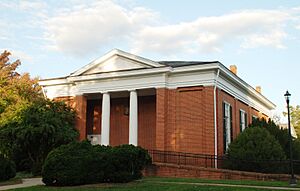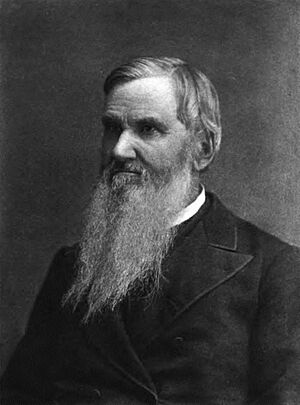Robert Lewis Dabney facts for kids
Quick facts for kids
Robert Lewis Dabney
|
|
|---|---|
 |
|
| Born |
Robert Lewis Dabney
March 5, 1820 |
| Died | January 3, 1898 (aged 77) |
| Resting place | Union Presbyterian Seminary Cemetery Hampden-Sydney, Virginia |
| Nationality | American |
| Education | Hampden-Sydney College University of Virginia Union Theological Seminary |
| Occupation |
|
| Parent(s) | Charles Dabney Elizabeth Randolph Price Dabney. |
| Signature | |
Robert Lewis Dabney (March 5, 1820 – January 3, 1898) was an American Christian thinker and teacher. He was also a Southern Presbyterian minister, a Confederate States Army chaplain, and an architect. During the American Civil War, he served as chief of staff and biographer for General Stonewall Jackson. His book about Jackson's life is still available today.
Dabney and James Henley Thornwell were important thinkers in Southern Presbyterianism. They followed Calvinist ideas, which is a branch of Protestant Christianity. They were also "Old School Presbyterians," meaning they held traditional views. While some modern Presbyterian churches still value their religious writings, these churches do not agree with Dabney's and Thornwell's past beliefs about race and their support for slavery.
Contents
About Robert Lewis Dabney's Life
Growing Up and Education
Robert Lewis Dabney was born on March 5, 1820. He was the sixth child in his family. His parents were Charles William Dabney and Elizabeth Randolph Price Dabney. His family had roots in France, coming from a group called Huguenots who settled in Virginia in the 1600s.
He went to Hampden-Sydney College and earned a Bachelor of Arts degree in 1837. Later, he received a master's degree from the University of Virginia in 1842. He then studied at Union Presbyterian Seminary and graduated in 1846.
His Career and Work
After his studies, Dabney worked as a missionary in Louisa County, Virginia, from 1846 to 1847. He then became a pastor at Tinkling Spring Presbyterian Church from 1847 to 1853. During this time, he also ran a school. He is remembered as an important person from Providence Presbyterian Church.
At Tinkling Spring, he met Margaret Lavinia Morrison. They got married on March 28, 1848. They had six sons, but sadly, three of them died young from an illness called diphtheria.
From 1853 to 1869, Dabney was a professor at Union Theological Seminary. He taught about church history and later about systematic theology, which is the study of religious beliefs in an organized way. In 1883, he became a professor of philosophy at the University of Texas.
Dabney's health declined by 1894, and he retired from full-time work. However, he still gave lectures sometimes. He also helped lead the Hampden-Sydney College Church from 1858 to 1874.
Dabney and the Civil War
Dabney was involved in the American Civil War. In the summer of 1861, he was a chaplain for the 18th Virginia Infantry in the Confederate army. The next year, he became chief of staff for General Stonewall Jackson during important battles like the Valley Campaign and the Seven Days Battles.
Dabney's Architectural Designs
Robert Lewis Dabney also designed buildings. His plans for the Tinkling Spring Presbyterian Church and two other churches in Virginia helped shape church architecture in the state. Three buildings he was involved with are listed on the U.S. National Register of Historic Places. These include Tinkling Spring Presbyterian Church, Briery Church in Briery, Virginia, and New Providence Presbyterian Church near Brownsburg, Virginia.
His Final Years
Robert Lewis Dabney passed away on January 3, 1898. He died from problems related to a sudden illness.
Important Books and Writings
Dabney wrote many books and essays during his life. Here are some of his major works:
- Memoir of Rev. Dr. Francis S. Sampson (1855)
- Life of General Thomas J. Jackson (1866)
- A Defense of Virginia, and Through Her, of the South, in Recent and Pending Contests Against the Sectional Party (1867)
- Lectures on Sacred Rhetoric (1870)
- Women's Rights women (1871)
- Syllabus and Notes of the Course of Systematic and Polemic Theology (1871), later called Systematic Theology.
- Sensualistic Philosophy of the Nineteenth Century Examined (1875)
- Practical Philosophy (1897)
- Penal Character of the Atonement of Christ Discussed in the Light of Recent Popular Heresies (1898, published after his death)
- Discussions (1890–1897), a collection of his shorter essays in four volumes:
- Theological and Evangelical (1890)
- Evangelical (1891)
- Philosophical (1892)
- Secular (1897)
These collections were later expanded into five volumes.



